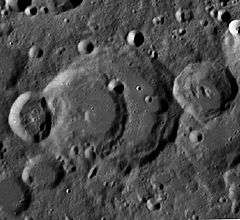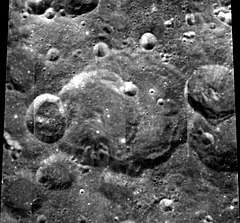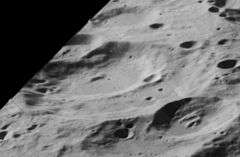Perrine (crater)
Perrine is a lunar impact crater that is located on the northern hemisphere on the far side of the Moon. It lies to the west of the large walled plain Landau, and to the northeast of the crater Charlier. To the north-northwest is the smaller Gullstrand.
 LRO image | |
| Coordinates | 42.5°N 127.8°W |
|---|---|
| Diameter | 86 km |
| Depth | Unknown |
| Colongitude | 128° at sunrise |
| Eponym | Charles D. Perrine |


This is an unusual formation that forms part of a chain of connected craters. The western two-thirds of Perrine is overlain by the slightly smaller Perrine S, so that Perrine is crescent-shaped. The western rim of Perrine S is overlain by the still-smaller Perrine T. Perrine S has a worn outer rim, and a small central peak in the middle of the floor.
The surviving rim of Perrine is worn and eroded, with the overlapping pair Perrine E and Perrine G intruding slightly into the eastern rim. A smaller crater has disrupted the southwest end of the outer rim, and a pair of small craters are attached to the northern rim.
Only a small portion of the interior floor of Perrine still survives, forming a crescent-shaped surface between the outer rampart of Perrine S and the inner wall of Perrine. It is marked by a pair of tiny craterlets in the northern half.
Satellite craters
By convention these features are identified on lunar maps by placing the letter on the side of the crater midpoint that is closest to Perrine.
| Perrine | Latitude | Longitude | Diameter |
|---|---|---|---|
| E | 42.8° N | 124.9° W | 40 km |
| G | 42.1° N | 124.6° W | 58 km |
| L | 39.2° N | 127.2° W | 37 km |
| S | 42.5° N | 128.6° W | 63 km |
| T | 42.4° N | 130.2° W | 34 km |
References
- Andersson, L. E.; Whitaker, E. A. (1982). NASA Catalogue of Lunar Nomenclature. NASA RP-1097.CS1 maint: ref=harv (link)
- Blue, Jennifer (July 25, 2007). "Gazetteer of Planetary Nomenclature". USGS. Retrieved 2007-08-05.CS1 maint: ref=harv (link)
- Bussey, B.; Spudis, P. (2004). The Clementine Atlas of the Moon. New York: Cambridge University Press. ISBN 978-0-521-81528-4.CS1 maint: ref=harv (link)
- Cocks, Elijah E.; Cocks, Josiah C. (1995). Who's Who on the Moon: A Biographical Dictionary of Lunar Nomenclature. Tudor Publishers. ISBN 978-0-936389-27-1.CS1 maint: ref=harv (link)
- McDowell, Jonathan (July 15, 2007). "Lunar Nomenclature". Jonathan's Space Report. Retrieved 2007-10-24.CS1 maint: ref=harv (link)
- Menzel, D. H.; Minnaert, M.; Levin, B.; Dollfus, A.; Bell, B. (1971). "Report on Lunar Nomenclature by the Working Group of Commission 17 of the IAU". Space Science Reviews. 12 (2): 136–186. Bibcode:1971SSRv...12..136M. doi:10.1007/BF00171763.CS1 maint: ref=harv (link)
- Moore, Patrick (2001). On the Moon. Sterling Publishing Co. ISBN 978-0-304-35469-6.CS1 maint: ref=harv (link)
- Price, Fred W. (1988). The Moon Observer's Handbook. Cambridge University Press. ISBN 978-0-521-33500-3.CS1 maint: ref=harv (link)
- Rükl, Antonín (1990). Atlas of the Moon. Kalmbach Books. ISBN 978-0-913135-17-4.CS1 maint: ref=harv (link)
- Webb, Rev. T. W. (1962). Celestial Objects for Common Telescopes (6th revised ed.). Dover. ISBN 978-0-486-20917-3.CS1 maint: ref=harv (link)
- Whitaker, Ewen A. (1999). Mapping and Naming the Moon. Cambridge University Press. ISBN 978-0-521-62248-6.CS1 maint: ref=harv (link)
- Wlasuk, Peter T. (2000). Observing the Moon. Springer. ISBN 978-1-85233-193-1.CS1 maint: ref=harv (link)